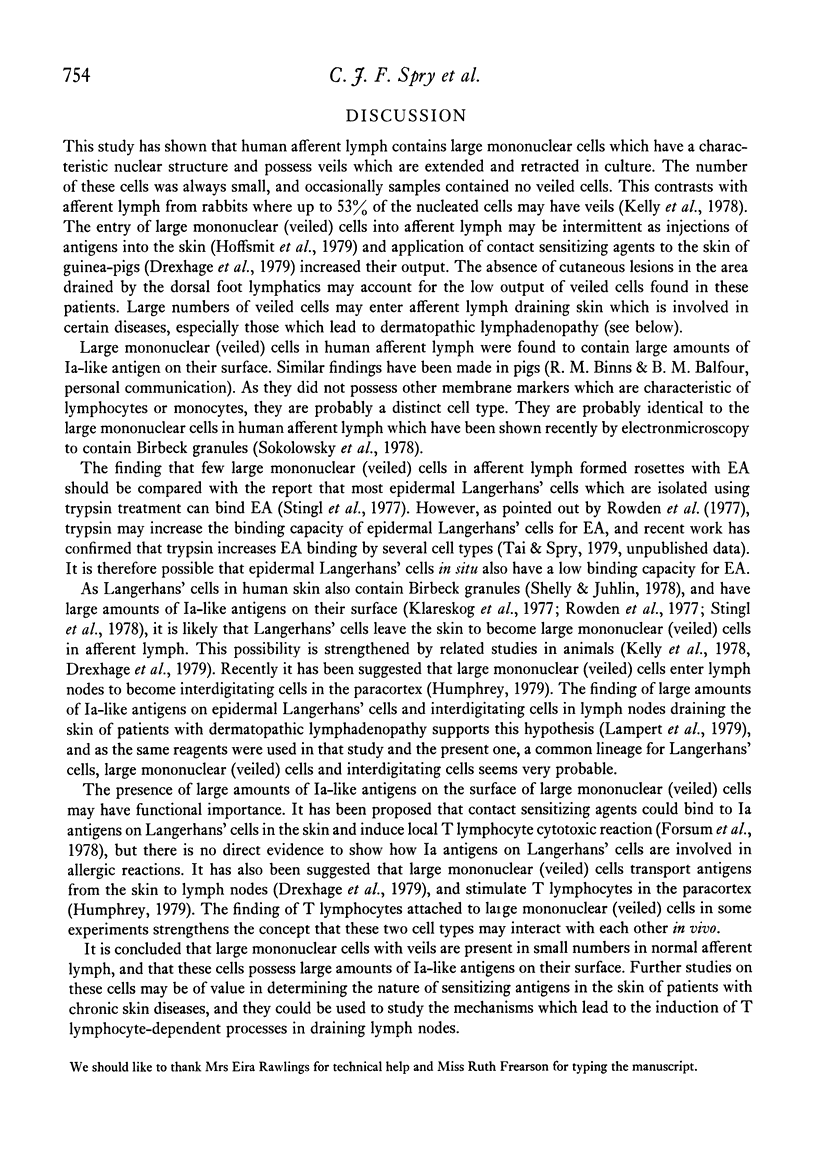Abstract
Studies were done to see whether large mononuclear cells in human afferent lymph possess cytoplasmic veils or Ia-like antigens on their surface. Small numbers of veiled cells were seen in lymph from five subjects: one with post-phlebitis oedema, one with trophic ulcers of the legs, one with common variable immoglobulin deficiency, and two control subjects. They were not seen in afferent lymph from two other patients with oedema of the legs, and one control subject. Only occasional large mononuclear (veiled) cells formed rosettes with IgG-coated erythrocytes, and they did not attach to glass after overnight culture. They had a distinctive nuclear structure and fluorescent antisera showed that their membranes and veils possessed large amounts of 'Ia-like' antigens. They did not have surface immunoglobulin or a monocyte membrane antigen. It was concluded that the membrane and nuclear structure of human large mononuclear (veiled) cells is in keeping with the possibility that they are derived from Langerhans' cells in the skin, and that they can become interdigitating cells in lymphoid tissues. It is suggested that these cells have an important role in the transport of antigens from the skin and the stimulation of T lymphocytes in lymphoid tissues.
Full text
PDF





Images in this article
Selected References
These references are in PubMed. This may not be the complete list of references from this article.
- Engeset A., Sokolowski J., Olszewski W. L. Variation in output of leukocytes and erythrocytes in human peripheral lymph during rest and activity. Lymphology. 1977 Dec;10(4):198–203. [PubMed] [Google Scholar]
- Godal T., Engeset A. A preliminary note on the composition of lymphocytes in human peripheral lymph. Lymphology. 1978 Dec;11(4):208–210. [PubMed] [Google Scholar]
- Greaves M. F., Falk J. A., Falk R. E. A surface antigen marker for human monocytes. Scand J Immunol. 1975 Sep;4(5-6):555–562. doi: 10.1111/j.1365-3083.1975.tb02661.x. [DOI] [PubMed] [Google Scholar]
- Janossy G., Goldstone A. H., Capellaro D., Greaves M. F., Kulenkampff J., Pippard M., Welsh K. Differentiation linked expression of p28,33 (Ia-like) structures on human leukaemic cells. Br J Haematol. 1977 Nov;37(3):391–402. doi: 10.1111/j.1365-2141.1977.tb01010.x. [DOI] [PubMed] [Google Scholar]
- Kelly R. H., Balfour B. M., Armstrong J. A., Griffiths S. Functional anatomy of lymph nodes. II. Peripheral lymph-borne mononuclear cells. Anat Rec. 1978 Jan;190(1):5–21. doi: 10.1002/ar.1091900103. [DOI] [PubMed] [Google Scholar]
- Klareskog L., Tjernlund U., Forsum U., Peterson P. A. Epidermal Langerhans cells express Ia antigens. Nature. 1977 Jul 21;268(5617):248–250. doi: 10.1038/268248a0. [DOI] [PubMed] [Google Scholar]
- Morris B., Courtice F. C. Cells and immunoglobulins in lymph. Lymphology. 1977 Jun;10(2):62–70. [PubMed] [Google Scholar]
- Rowden G., Lewis M. G., Sullivan A. K. Ia antigen expression on human epidermal Langerhans cells. Nature. 1977 Jul 21;268(5617):247–248. doi: 10.1038/268247a0. [DOI] [PubMed] [Google Scholar]
- Sokolowski J., Jakobsen E., Johannessen J. V. Cells in peripheral leg lymph of normal men. Lymphology. 1978 Dec;11(4):202–207. [PubMed] [Google Scholar]
- Stingl G., Katz S. I., Abelson L. D., Mann D. L. Immunofluorescent detection of human B cell alloantigens on S-Ig-positive lymphocytes and epidermal Langerhans cells. J Immunol. 1978 Feb;120(2):661–664. [PubMed] [Google Scholar]
- Stingl G., Wolff-Schreiner E. C., Pichler W. J., Gschnait F., Knapp W., Wolff K. Epidermal Langerhans cells bear Fc and C3 receptors. Nature. 1977 Jul 21;268(5617):245–246. doi: 10.1038/268245a0. [DOI] [PubMed] [Google Scholar]
- Tai P. C., Spry C. J. Studies on blood eosinophils. I. Patients with a transient eosinophilia. Clin Exp Immunol. 1976 Jun;24(3):415–422. [PMC free article] [PubMed] [Google Scholar]




